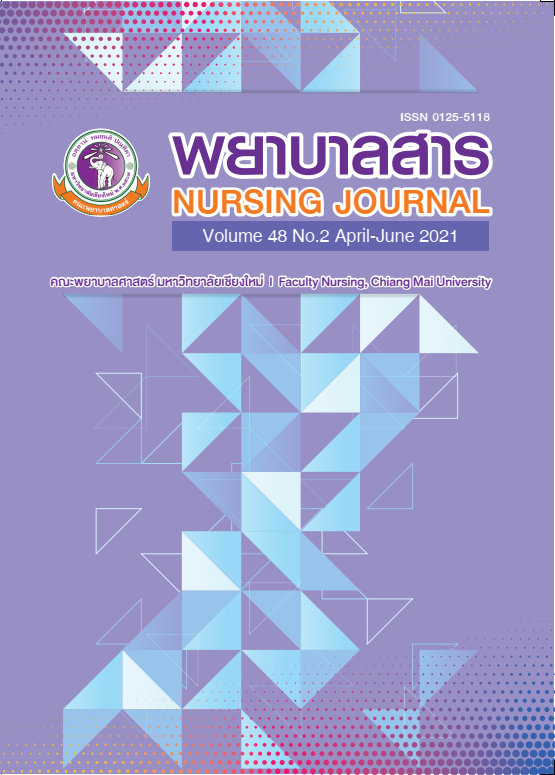Factors Predicting Self-Management Among Older Persons with Benign Prostatic Hyperplasia
Keywords:
Factors predicting, Self-management, Older persons, Benign prostatic hyperplasiaAbstract
Benign prostatic hyperplasia (BPH) is a major problem of the urinary system. BPH affects the daily and social life of older males. Suitable self-management is a method for reducing the impact of this chronic disease. The objective of this study was to describe self-management skills and examine predicting factors of self-management in older persons with BPH. The predicting factors included knowledge on disease and self-management practices, self-efficacy regarding self-management, and social support. Participants were people aged 60 years and over who were diagnosed with BPH and attending the urological outpatient clinic at Lampang Hospital (n = 120). Data were collected through interviews using five instruments. These instruments consisted of demographic data record form, self-management behavior scale, knowledge on disease and self-management practices scale, self-efficacy regarding self-management scale, and social support scale. Data were analyzed using descriptive statistics and stepwise multiple regression analysis.
The results showed that:
- The overall self-management score of the participants was at a moderate level. Dimensions of self-management, role, and emotional management were at a high level. The other dimension of self-management, medical management, was at a moderate level.
- Only self-efficacy was a significant predictor for self-management and was able to explain 8% of variance in older persons with BPH (R2 = 0.08, F = 10.234, p < .01). Self-efficacy regarding self-management (β = .282, p < .01) was the most important predictor of self-management among older persons with BPH. Knowledge on disease and self-management practices as well as social support had no significant prediction for self-management.
The results of this study can be used as basic information for nurses and healthcare providers to develop self-management programs for older persons with BPH.
References
Boonyaratvej, P., & Santingankul, A. (2011). Benign prostatic hyperplasia. Bangkok: Amarin printing and publishing. (In Thai)
Fourcade, R. O., Lacoin, F., Roupret, M., Slama, A., Le Fur, C., Michel, E., Cotte, F. E. (2012). Outcomes and general health-related quality of life among patients medically treated in general daily practice for lower urinary tract symptoms due to benign prostatic hyperplasia. World Journal Urology, 30(3), 419-426. doi:10.1007/s00345-011-0756-2
House, J. S. (1981). Work stress and social support. California: Addison-Wesley.
Kahn, R. L., Goldfarb, A. I., Pollack, M., & Peck, A. (1960). Brief objective measure for the determination of mental status in the aged. American Journal of Psychiatry, 117, 326-328.
Klinklom, S. (2014). Self-management behaviors and relate factors among older persons with benign prostatic hyperplasia (Master of Nursing Science, Gerontological Nursing). Graduate School, Chiang Mai University. (In Thai)
Lee, H. W., Kim, S. A., Nam, J. W., Kim, M. K., Choi, B. Y., & Moon, H. S. (2014). The study about physical activity for subjects with prevention of benign prostate hyperplasia. International Neurology Journal, 18(3), 155-162. doi:10.5213/inj.2014.18.3.155
Li, H., Jiang, F. Y., & Lin, C. C. (2014). Factors associated with self-management by people undergoing hemodialysis: A descriptive study. International Journal of Nursing Studies, 51, 208-216. doi:10.1016/j.ijnurstu.2013.05.012
Lorig, K., & Holman, H. (2003). Self-management education: History, definition, outcomes, and mechanisms. Annals of Behavioral Medicine, 26(1), 1-7.
Matondang, F. A., & Rahardjo, H. E. (2014). Management of male lower urinary tract symptoms suggestive of benign prostatic hyperplasia by general practitioners in Jakarta. Prostate International, 2(2), 97-103. doi:10.12954/pi.14040
Miranda, P. E., Gomes, M. C., Torricelli, M. C. F., Junior, B. J., Castro E. J., SilvaFerruri, G. A., Srougi, M. (2014). Nocturia is the lower urinary tract symptom with greatest impact on quality of life of men from a community setting. International Neurology Journal, 18, 86-90. doi:10.5213/inj. 2014.18.2.86
Osborne, J. W. (2000). Prediction in multiple regression. Practical Assessment, Research & Evaluation, 7(2), 1-6.
Phetarvut, S., Wattunyu, N., & Suwonnaroop, N. (2011). Factors predicting diabetes self-management behavior among patient with diabetes mellitus type 2. Journal of Nursing Science, 29(4), 18 – 26. (In Thai)
Powers, M. A., Bardsley, J., Cypress, M., Duker, P., Funnell, M. M., Fischl, A. H., ... Vivian, E. (2015). Diabetes Self-management Education and Support in Type 2 diabetes: A joint position statement of the American Diabetes Association, the American Association of Diabetes Educators, and the Academy of Nutrition and Dietetics. Diabetes Care, 38,1372–1382. doi: 10.2337/dc15-0730
Ramesh, A., & Kartheek, S. (2009). Study of impact of patient education on health related quality of life in benign prostatic hyperplasia (BPH) patient in A South Indian Teaching Hospital. Asian Journal of Pharmaceutical and Clinical Research, 2(4), 97-103.
Srikong, P., & Euakit, N. (2010). Selected factors related to self-management on dietary control among heart failure patients in lower northeast region (Master of Nursing Science). Graduate School, Khon Kaen University. (In Thai)
Sayani, A., Ismaila, A., Walker, A., Posnett, J., Laroche, B., Nickel, J. C., & Su, Z. (2014). Cost analysis of fixed-dose combination of dutasteride and tamsulosin compared with concomitant dutasteride and tamsulosin monotherapy in patients with benign prostatic hyperplasia in Canada. Canadian Urology Association Journal, 8(1-2), E1-E7. doi:10.5489/cuaj.755
Sookkhum, W. (2015). Effects perceived self-efficacy in weight controlling promoting program on consumption behaviours waist circumference and body mass index among obese elderly (Master of Nursing Science). Graduate School, Chulalongkorn University. (In Thai)
Downloads
Published
How to Cite
Issue
Section
License
บทความที่ได้รับการตีพิมพ์เป็นลิขสิทธิ์ของวารสารพยาบาลสาร
ข้อความที่ปรากฏในบทความแต่ละเรื่องในวารสารวิชาการเล่มนี้เป็นความคิดเห็นส่วนตัวของผู้เขียนแต่ละท่านไม่เกี่ยวข้องกับมหาวิทยาลัยเชียงใหม่ และคณาจารย์ท่านอื่นๆในมหาวิทยาลัยฯ แต่อย่างใด ความรับผิดชอบองค์ประกอบทั้งหมดของบทความแต่ละเรื่องเป็นของผู้เขียนแต่ละท่าน หากมีความผิดพลาดใด ๆ ผู้เขียนแต่ละท่านจะรับผิดชอบบทความของตนเองแต่ผู้เดียว






